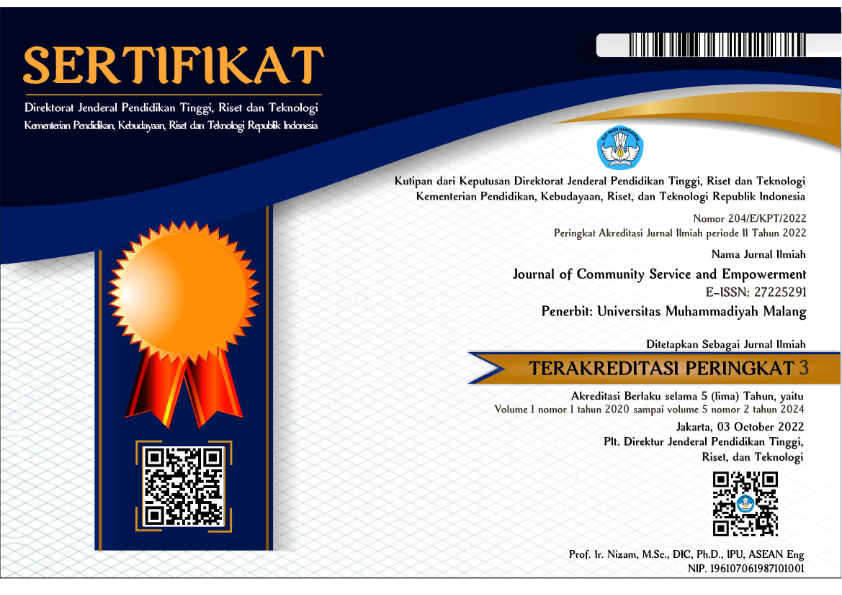Introduction and early measurement of carbon footprint concepts to respond the challenge of SDGs-Goal 13
DOI:
https://doi.org/10.22219/jcse.v1i2.12322Keywords:
carbon footprint, early measurement, global warmingAbstract
One of the efforts to prevent the effects of climate change was the introduction of the concept of carbon footprints from an early age to students. Science subjects in this school have included elements of environmental knowledge in their subject matter. However, mitigation and adaptation efforts to climate change were still lacking recognition. The purpose of this study was to introduce and measure the extent to which elementary students are able to recognize the concept of carbon footprints and can use a simple carbon footprint calculator application in climate change mitigation and adaptation efforts. The study was conducted at MIM Kupang Karangdowo Klaten, Central Java. The activity was carried out on February 19, 2020 with the method of lectures, interviews, and simulations, followed by 11 teachers and 21 grade VI students. The flow of activities was divided into 3, namely: (1) counseling/explanation of the carbon cycle, global warming, carbon footprint and carbon footprint calculator, (2) interviews about the student's daily and weekly lifestyle or carbon footprint pattern, (3) socialization of the footprint calculator application carbon and usability observations. The activity ended with a simulation of a carbon footprint calculator for several students. From the study conducted, it can be seen that students are interested in this carbon footprint concept and were technically assessed as being able to use a carbon calculator without significant obstacles.Downloads
References
Blonk, H., Kool, A., Luske, B., Ponsioen, T., & Scholten, J. (2010). Methodology for assessing carbon footprints of horticultural products horticultural products. CA Gouda: Blonk Milieu Advies BV.
Citraningrum, M. (2019). Energi kita. Jakarta: Institute for Essential Service Reform.
Dahlan, E. N. (2007). Analisis kebutuhan luasan hutan kota sebagai sink gas CO2 antropogenik dari bahan bakar minyak dan gas (Program Studi Ilmu Pengetahuan Kehutanan, IPB). Retrieved from https://repository.ipb.ac.id/handle/123456789/40542
Hansen, M. C., Potapov, P. V., Moore, R., Hancher, M., Turubanova, S. A., Tyukavina, A., … Townshend, J. R. G. (2013). High-resolution global maps of 21st-century forest cover change. Science, 342(6160), 850–853. https://doi.org/10.1126/science.1244693
Hudha, A. M., Husamah, H., & Rahardjanto, A. (2019). Etika Lingkungan (Teori dan praktik pembelajarannya). Malang, Indonesia: UMM Press.
Husamah, H., & Rahardjanto, A. (2019). Bioindikator (Teori dan aplikasi dalam biomonitoring). Malang: UMM Press.
IESR Indonesia. (2011). Potensi penurunan emisi Indonesia melalui perubahan gaya hidup individu. Jakarta.
IESR Indonesia. (2020). Jejak karbon (Carbon footprint). Retrieved April 14, 2020, from IESR Indonesia website: http://www.iesr.or.id/kkv3/tentang-jejak-karbon/
IPCC. (2018). Global warming of 1.5°C An IPCC Special Report on the impacts of global warming of 1.5°C above pre-industrial levels and related global greenhouse gas emission pathways, in the context of strengthening the global response to the threat of climate change, (V. Masson-Delmotte, P. Zhai, H.-O. Pörtner, D. Roberts, J. Skea, P. R. Shukla, … T. Waterfield, Eds.). Intergovernmental Panel on Climate Change.
Ismiyati, Marlita, D., & Saidah, D. (2014). Pencemaran udara akibat emisi gas buang kendaraan bermotor. Jurnal Manajemen Transportasi & Logistik (JMTransLog), 1(3), 241–248. Retrieved from https://media.neliti.com/media/publications/112707-ID-pencemaran-udara-akibat-emisi-gas-buang.pdf
Kenny, T., & Gray, N. F. (2009). A preliminary survey of household and personal carbon dioxide emissions in Ireland. Environment International, 35(2), 259–272. https://doi.org/10.1016/j.envint.2008.06.008
Loyarte-López, E., Barral, M., & Morla, J. C. (2020). Methodology for carbon footprint calculation towards sustainable innovation in intangible assets. Sustainability (Switzerland), 12(4), 1–14. https://doi.org/10.3390/su12041629
Margono, B. A., Potapov, P. V., Turubanova, S., Stolle, F., & Hansen, M. C. (2014). Primary forest cover loss in indonesia over 2000-2012. Nature Climate Change, 4(8), 730–735. https://doi.org/10.1038/nclimate2277
Pandey, D., Agrawal, M., & Pandey, J. S. (2011). Carbon footprint: Current methods of estimation. Environmental Monitoring and Assessment, 178(1–4), 135–160. https://doi.org/10.1007/s10661-010-1678-y
Panjiwibowo, C., Soejachmoen, M. H., Tanujaya, O., & Rusmantoro, W. (2003). Mencari pohon uang: CDM kehutanan di Indonesia. Jakarta: Pelangi.
Prihatmaji, Y. P., Fauzy, A., Rais, S., & Firdaus, F. (2016). Analisis carbon footprint gedung perpustakaan pusat, sebagai preduksi emisi gas rumah kaca. AJIE - Asian Journal of Innovation and Entrepreneurship (e-ISSN:, 1(2), 148–155. Retrieved from https://journal.uii.ac.id/ajie/article/view/6372
Santoso, A. D. (2017). Jejak karbon individu pegawai di instansi pemerintah. Jurnal Teknologi Lingkungan, 18(2), 233–240. Retrieved from http://ejurnal.bppt.go.id/index.php/JTL/article/download/2242/1885
Sulistyono, S. (2005). Pemanasan global (Global Warming) dan hubungannya dengan penggunaan bahan bakar fosil. Forum Teknologi, 2(2), 47–56. Retrieved from http://ejurnal.ppsdmmigas.esdm.go.id/sp/index.php/swarapatra/article/view/60/49
The World Bank. (2016). CO2 emissions (metric tons per capita). Retrieved April 14, 2020, from Carbon Dioxide Information Analysis Center, Environmental Sciences Division, Oak Ridge National Laboratory, Tennessee, United States website: https://data.worldbank.org/indicator/EN.ATM.CO2E.PC
UN ESCAP. (2012). Statistical yearbook for Asia and the Pacific 2015. In Sustainable Development Goal 13. UN ESCAP.
UNDP. (2016). UNDP support to the implementation of sustainable development goal 13: Taking urgent action to combat climate change and its impacts. https://doi.org/10.4324/9781351067478-8
Wibowo, M. A., Sholeh, M. N., & Rizkyawan, A. W. (2020). Lean construction: Evaluation of waste and carbon footprint in construction project. IOP Conference Series: Earth and Environmental Science, 448(1), 012057. https://doi.org/10.1088/1755-1315/448/1/012057
Wiedmann, T., & Barrett, J. (2010). A review of the ecological footprint indicator-perceptions and methods. Sustainability, 2(6), 1645–1693. https://doi.org/10.3390/su2061645
Wright, L. A., Kemp, S., & Williams, I. (2011). “Carbon footprinting”: Towards a universally accepted definition. Carbon Management, 2(1), 61–72. https://doi.org/10.4155/cmt.10.39
Wulandari, M. T., Hermawan, & Purwanto. (2013). Kajian emisi Co2 berdasarkan penggunaan energi rumah tangga sebagai penyebab pemanasan global (Studi kasus Perumahan Sebantengan, Gedang Asri, Susukan RW 07 Kab. Semarang). Prosiding Seminar Nasional Pengelolaan Sumberdaya Alam Dan Lingkungan 2013, 434–440. Retrieved from https://core.ac.uk/download/pdf/18605659.pdf
WWF. (2020). Carbon footprint: Exploring the UK’s contribution to climate change. Retrieved from https://www.wwf.org.uk/sites/default/files/2020-04/FINAL-WWF-UK_Carbon_Footprint_Analysis_Report_March_2020 %28003%29.pdf
Zhu, X., Zhang, T., Gao, W., & Mei, D. (2020). Analysis on spatial pattern and driving factors of carbon emission in urban-rural fringe mixed-use communities: Cases study in East Asia. Sustainability (Switzerland), 12(8), 1–16. https://doi.org/10.3390/SU12083101














